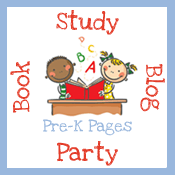Chapter Ten of
Literacy Beginnings
, an introductory chapter,
Learning to Read: Three Critical Areas of Early Learning, outlines the three critical areas involved with learning to read. We all know introducing children to books, concepts of print, and story language can never begin to soon. Many children arrive at preschool and kindergarten without these crucial foundations in place. Fountas and Pinnell explain the areas and then provide activities and examples for each in your classroom.
As I’m a visual guy (I love charts, graphs, and anything that organizes information for me), I’ve decided to break my discussion of this chapter into Theory and Practice as it relates to the classroom.
1.
Story Awareness
Theory: Quite simply, story awareness is the understanding that books have meaning and tell stories.
In Practice: Wordless books are an amazing way to promote story awareness. Fountass and Pinell suggest many, but my favorites are
Alexandra Day’s Carl series
. Sitting with a small group or even one on one with a child, I might model how the pictures tell a story and then ask for them to contribute their own ideas about what’s happening. For older kids who are ready, these wordless books are a wonderful way to begin writing exercises without having to worry about illustrating.
2.
Language Awareness
Theory: When children begin ‘talking like a book,’ using the pictures to retell familiar stories, they are beginning to understand that written text, when read aloud, sounds different from ordinary speaking.
In Practice: Nothing helps develop the understanding of language awareness more than interactive read-alouds (Chapter Eleven dives deeper into this practice). The authors suggest simple stories, but also encourage us to find those with more complex language to "stretch children’s knowledge of complex sentences, such as those in
Lilly’s Purple Plastic Purse
.” (page 109) I couldn’t help but smile when I read this as the book, and all of Kevin Henkes, are a personal favorite of mine.
Fountas and Pinnell also suggest finding several books in a series (such as
Tacky the Penguin
) to help children begin to understand characters and build relationships with them. They offer many other examples to point you in the right direction.
I found this
video of a teacher doing a read aloud in a first grade classroom in Deleware. It really illustrates the ‘interactive’ part of reading aloud.
3.
Print awareness
Theory: When children learn to enjoy stories being read aloud, they begin to understand a multitude of concepts of print. The book has a wonderful bulleted list of the plethora of concepts even the youngest learners begin to grasp (page 110). They call their list ‘early reading behaviors’ and stress the internalization of them.
In Practice: Big books, big books, BIG BOOKS! Kids adore big books. The pictures are giant… so are the words. Big books give teachers a whole lot of bang for the buck (they’re usually expensive, but I’ve found Scholastic will let you use points to order them for free). What better way to explicitly model concepts of print as well as introduce comprehension strategies than with pictures and text easily seen by every child.
As we read aloud, it’s important to remember to stop and point out details we may find obvious. During the first few weeks of kindergarten, I always make a point to talk about the spaces in between words. I often point to each word as I read it aloud, reinforcing one to one correspondence. If I have children that have little exposure to books, I will talk about the cover, how I read the text (direction and return sweep), and turn the page. Every part of reading the book is a ritual to be explained, enjoyed, and exalted.
Finally, as they do with every chapter, Fountas and Pinnell summarize the key points of the chapter for the reader... always a nice touch with a large text.
Tomorrow, in Chapter Eleven, we’ll look more closely at the heart of every early childhood classroom – the interactive read-aloud.
Grab the button below:







